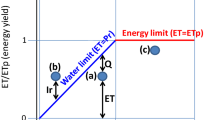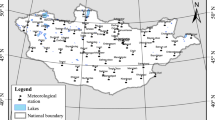Abstract
There is great interest in understanding how climate change will impact aridity through the interaction of precipitation changes with rising temperatures. The Aridity Index (AI), Climatic Moisture Deficit (CMD), and Climatic Moisture Surplus (CMS) are metrics commonly used to quantify and map patterns in aridity and water cycling. Here we show that these metrics have different patterns of change under future climate—based on an ensemble of nine general circulation climate models—and the different metrics are appropriate for different purposes. Based on these differences between the metrics, we propose that aridity can be dissected into three different types—hydrological (CMS), agricultural (CMD), and meteorological. In doing this, we propose a novel modified version of the Aridity Index, called AI+, that can be useful for assessing changes in meteorological aridity. The AI + is based on the same ratio between precipitation and evapotranspiration as the traditional AI, but unlike the traditional AI, the AI + only accounts for changes to precipitation during months when precipitation is less than reference/potential evapotranspiration (i.e. there is a deficit). Moreover, we show that the traditional AI provides a better estimate of change in moisture surplus driven by changes to precipitation during the wet season, rather than changes in deficit that occur during the drier seasons. These results show that it is important to select the most appropriate metric for assessing climate driven changes in aridity.







Similar content being viewed by others
References
Alcamo J, Doll P, Henrichs T, Kaspar F, Lehner B, Rosch T, Siebert S (2003) Global estimates of water withdrawals and availability under current and future “business-as-usual” conditions. Hydrol Sci J-J Des SciHydrol 48:339–348
Allen RG, Pereira LS, Raes D, Smith M (1998) Crop evapotranspiration - Guidelines for computing crop water requirements - FAO Irrigation and drainage paper 56. Food and Agriculture Organization of the United Nations, Rome
Allen CD, Macalady AK, Chenchouni H, Bachelet D, McDowell N, Vennetier M, Kitzberger T, Rigling A, Breshears DD, Hogg EH, Gonzalez P, Fensham R, Zhang Z, Castro J, Demidova N, Lim JH, Allard G, Running SW, Semerci A, Cobb N (2010) A global overview of drought and heat-induced tree mortality reveals emerging climate change risks for forests. For Ecol Manag 259:660–684
Arnell NW, Gosling SN (2013) The impacts of climate change on river flow regimes at the global scale. J Hydrol 486:351–364
Bannayan M, Sanjani S, Alizadeh A, Lotfabadi SS, Mohamadian A (2010) Association between climate indices, aridity index, and rainfed crop yield in northeast of Iran. Field Crops Res 118:105–114
Biggs TW, Mishra PK, Turral H (2008) Evapotranspiration and regional probabilities of soil moisture stress in rainfed crops, southern India. Agric For Meteorol 148:1585–1597
Breshears DD, Myers OB, Meyer CW, Barnes FJ, Zou CB, Allen CD, McDowell NG, Pockman WT (2009) Tree die-off in response to global change-type drought: mortality insights from a decade of plant water potential measurements. Front Ecol Environ 7:185–189
Burke EJ, Brown SJ (2008) Evaluating uncertainties in the projection of future drought. J Hydrometeorol 9:292–299
Chou C, Tu JY, Tan PH (2007) Asymmetry of tropical precipitation change under global warming. Geophys Res Lett 34:5
Chou C, Chiang JCH, Lan C-W, Chung C-H, Liao Y-C, Lee C-J (2013) Increase in the range between wet and dry season precipitation. Nat Geosci 6:263–267
Copeland HE, Tessman SA, Girvetz EH, Roberts L, Enquist C, Orabona A, Patla S, Kiesecker J (2010) A geospatial assessment on the distribution, condition, and vulnerability of Wyoming’s wetlands. Ecol Indic 10:869–879
Dai A (2011) Drought under global warming: a review. Wiley Interdiscip Rev Clim Chang 2:45–65
Development Core Team R (2012) R: A language and environment for statistical computing. R Foundation for Statistical Computing. R Foundation for Statistical Computing, Vienna, 3-900051-07-0
Ellis AW, Hawkins TW, Balling RC, Gober P (2008) Estimating future runoff levels for a semi-arid fluvial system in central Arizona. USA Clim Res 35:227–239
ESRI (2012) ArcGIS 10.1. Environmental Systems Research Institute, Redlands
Federer CA, Vorosmarty C, Fekete B (1996) Intercomparison of methods for calculating potential evaporation in regional and global water balance models. Water Resour Res 32:2315–2321
Girvetz EH, Zganjar C, Raber GT, Maurer EP, Kareiva P, Lawler JJ (2009) Applied Climate-Change Analysis: The Climate Wizard Tool. PLoS One 4(12):e8320
Girvetz EH, Maurer EP, Duffy PB, Ruesch A, Thrasher B, Zganjar C (2013) Making climate data relevant to decision making: the important details of spatial and temporal downscaling. The World Bank, Washington, p 38
Kingston DG, Todd MC, Taylor RG, Thompson JR, Arnell NW (2009) Uncertainty in the estimation of potential evapotranspiration under climate change. Geophys Res Lett 36:L20403
McDonald RI, Girvetz EH (2013) Two challenges for U.S. Irrigation due to climate change: increasing irrigated area in wet states and increasing irrigation rates in dry states. PLoS One 8:e65589
Nakicenovic N, Alcamo J, Davis G, de Vries D, Fenhann J, Gaffin S, Gregory K, Grübler A, Jung TY, Kram T, Lebre La Rovere E, Michaelis L, Mori S, Morita T, Pepper W, Pitcher H, Price L, Riahi K, Roehrl A, Rogner H, Sankovski A, Schlesinger M, Shukla P, Smith S, Swart R, van Rooijen S, Victor NZD (2000) Special Report on Emissions Scenarios. A Special Report of Working Group III of the Intergovernmental Panel on Climate Change. Cambridge University Press, Cambridge
Narasimhan B, Srinivasan R (2005) Development and evaluation of Soil Moisture Deficit Index (SMDI) and Evapotranspiration Deficit Index (ETDI) for agricultural drought monitoring. Agric For Meteorol 133:69–88
Roy SB, Chen L, Girvetz EH, Maurer EP, Mills WB, Grieb TM (2012) Projecting water withdrawal and supply for future decades in the U.S. Under climate change scenarios. Environ Sci Technol 46(5):2545–2556
Rubel F, Kottek M (2010) Observed and projected climate shifts 1901–2100 depicted by world maps of the Koppen-Geiger climate classification. Meteorol Z 19:135–141
Sheffield J, Wood EF, Roderick ML (2012) Little change in global drought over the past 60 years. Nature 491:435–438
Stephenson NL (1998) Actual evapotranspiration and deficit: biologically meaningful correlates of vegetation distribution across spatial scales. J Biogeogr 25:855–870
Thrasher B, Maurer EP, McKellar C, Duffy PB (2012) Technical note: bias correcting climate model simulated daily temperature extremes with quantile mapping. Hydrol Earth Syst Sci 16:3309–3314
UNEP (1992) World Atlas of Desertification. United Nations Environment Program, London
van der Schrier G, Jones PD, Briffa KR (2011) The sensitivity of the PDSI to the thornthwaite and penman-monteith parameterizations for potential evapotranspiration. J Geophys Res 116:D03106
Verdin J, Funk C, Senay G, Choularton R (2005) Climate science and famine early warning. Philos Trans R Soc Lond B Biol Sci 360:2155–2168
Wilhite DA, Glantz MH (1985) Understanding: the drought phenomenon: the role of definitions. Water Int 10:111–120
Wisser D, Frolking S, Douglas EM, Fekete BM, Vorosmarty CJ, Schumann AH (2008) Global irrigation water demand: variability and uncertainties arising from agricultural and climate data sets. Geophys Res Lett 35:5
Wolock DM, McCabe GJ (1999) Explaining spatial variability in mean annual runoff in the conterminous United States. Clim Res 11:149–159
Zomer RJ, Bossio DA, Trabucco A, Yuanjie L, Gupta DC, Singh VP (2007) Trees and Water: Smallholder Agroforestry on Irrigated Lands in Northern India. International Water Management Institute, Colombo, p 45
Zomer RJ, Trabucco A, Bossio DA, van Straaten O, Verchot LV (2008) Climate change mitigation: a spatial analysis of global land suitability for clean development mechanism afforestation and reforestation. Agric Ecoyst Environ 126(1–2):67–80
Acknowledgments
We thank Peter Kareiva, Michelle Marvier, Craig Groves, and two anonymous reviewers for providing helpful comments on the manuscript, analysis and presentation of results.
Author information
Authors and Affiliations
Corresponding author
Electronic supplementary material
Below is the link to the electronic supplementary material.
Supplemental Fig. 1
Historic average (1961–1990) and future projected (2081–2100) change in temperature (average of minimum and maximum) and precipitation for the ensemble median of nine GCMs. Only areas below 60° north are shown (GIF 123 kb)
Supplemental Fig. 2
Histograms showing the distribution of historical average (left column) and future change for 2081–2100 under the SRES A2 emissions scenario (right column) for the four aridity metrics based on the 538 randomly selected points globally (separated by at least 2.0° in distance from one another) (GIF 84 kb)
Rights and permissions
About this article
Cite this article
Girvetz, E.H., Zganjar, C. Dissecting indices of aridity for assessing the impacts of global climate change. Climatic Change 126, 469–483 (2014). https://doi.org/10.1007/s10584-014-1218-9
Received:
Accepted:
Published:
Issue Date:
DOI: https://doi.org/10.1007/s10584-014-1218-9




